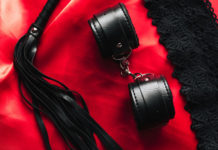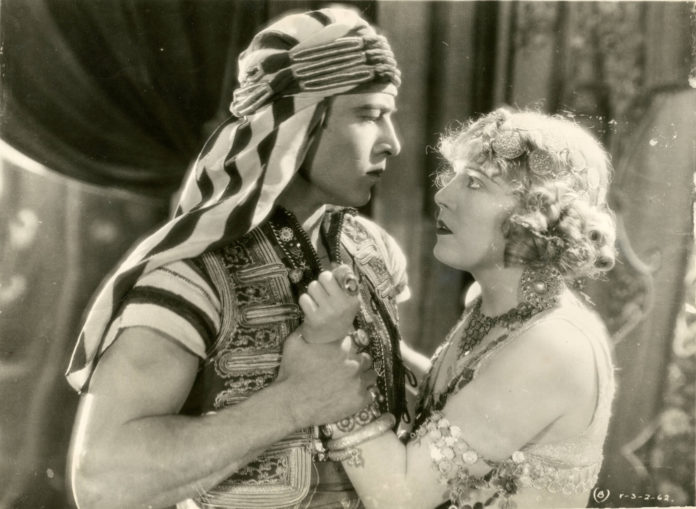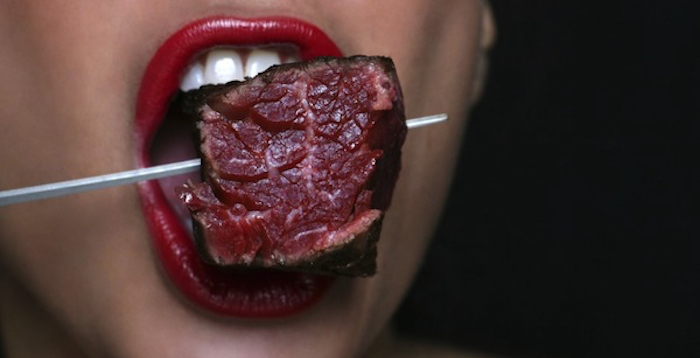“I am merely the canvas on which women paint their dreams.”–Rudolph Valentino
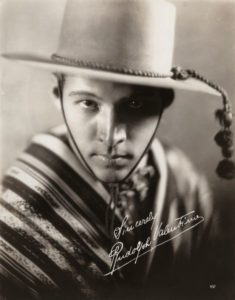 May 6 marks the birthday of a cinema legend–and of the premiere male sex symbol. And 2021 marks the hundredth anniversary of the film that might be considered the first erotic film for women. Would you be shocked to know that there’s a connection between the two?
May 6 marks the birthday of a cinema legend–and of the premiere male sex symbol. And 2021 marks the hundredth anniversary of the film that might be considered the first erotic film for women. Would you be shocked to know that there’s a connection between the two?
The world was blessed with Rudolph Valentino May 6, 1895. This Italian wunderkind made 39 films in 12 years, emerging as both a talented actor who spoke volumes with his eyes, movements and expressions, and as the living embodiment of female fantasy. Valentino was a man of many talents–acting, dancing, singing and boxing among them. Yet in this forum we shall focus on the Erotic Milestones of Valentino’s Career:
1. Valentino was the first sex symbol for women. The Saturday Evening Post, Vintage News, and many other news sources credit Valentino as the first male sex symbol. For while many handsome, appealing actors graced the silent screen prior to his arrival in Hollywood, he was the first to smolder on screen–his expressive dark-eyed stares, his sensual moves, his frenzied kisses and passionate embraces promising all of the heavenly sin that one mortal woman could possibly handle. His image provoked passionate responses in female audience members, tempting them to fantasize and enjoy their sexuality. Or, as film professor Miriam Hansen phrased it in a 1986 edition of Film Journal, Valentino’s popularity marked the birth of female spectatorship–the concept that female spectators or filmgoers were regarded as an economically and socially significant entity–and one of the few times in history that feminine desire was closely linked to their spectatorship (https://www.jstor.org/stable/1225080?seq=1). Translation: The ladies wanted that man. Bad.
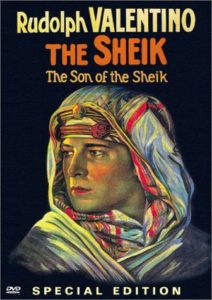 2. Valentino made the first erotic film for women. Whether playing Armand in Camille or Count Rodrigo in Cobra, Valentino imbued all of his heroes with romance, mystery and infinite charm. Yet it was in his role as the title character in 1921’s The Sheik that Valentino set fire to the screen, bringing a well-read romance novel to screen as he brought women to the theatre in droves. The Sheik contained no explicit scenes, but instead seethes with a hot undercurrent of brazen sensuality, balanced with passionate, life-binding romance. It was roles such as this one that lead Valentino to–in the words of Man’s World India (https://www.mansworldindia.com/culture/features/rudolph-valentino-sex-symbol-hollywood/)–“transform America’s idea of sex and the art of seduction.”
2. Valentino made the first erotic film for women. Whether playing Armand in Camille or Count Rodrigo in Cobra, Valentino imbued all of his heroes with romance, mystery and infinite charm. Yet it was in his role as the title character in 1921’s The Sheik that Valentino set fire to the screen, bringing a well-read romance novel to screen as he brought women to the theatre in droves. The Sheik contained no explicit scenes, but instead seethes with a hot undercurrent of brazen sensuality, balanced with passionate, life-binding romance. It was roles such as this one that lead Valentino to–in the words of Man’s World India (https://www.mansworldindia.com/culture/features/rudolph-valentino-sex-symbol-hollywood/)–“transform America’s idea of sex and the art of seduction.”
So The Sheik was the first sex movie for women. But was it a feminist statement? Well, yes and no. Yes, in the sense that–for the first time–women were encouraged and empowered to acknowledge their sensual needs, to explore their fantasies, and to claim at last their own form of erotic entertainment. And in the sense that the film’s heroine–Lady Diana Mayo, portrayed by the luminous Agnes Ayres–is strong and spirited in character. A big ol’ hell no, in that the character of the Sheik is at many times forceful and menacing.
Just as we now rediscuss and reassess problematic classics like Gone With the Wind, so must we reconsider The Sheik. And this discussion should include the consideration of the fact that–at the time of the film’s 1921 release–women who as much as contemplated sex were threatened with societal ruination and literal hellfire. This explains the framing story of the film, the presentation of which would NOT be acceptable in a modern production.
Today, however, the lingering images captured from the film involve the gorgeous vision of Valentino in silken robes, delivering sweltering kisses and bonding embraces that literally provoked swooning in female audience members at the time of the film’s release. It’s also important to note that Valentino himself publicly detested the character of the Sheik, and just as openly spoke in admiration of his wife Natacha Rambova, a silver screen pioneer who served the silent screen industry as a producer, set designer, writer, costume designer and actress.
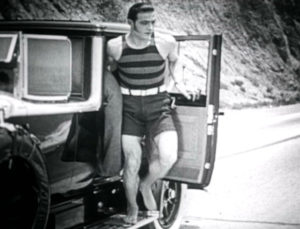
3. Valentino in all likelihood performed the first male striptease. On film, at least. In the short film The Sheik’s Physique, we follow Rudy as he enjoys an afternoon at the beach–changing into his swimsuit in his car before lounging languid on the sands. True, by modern standards we don’t get to see much (he only partially unbuttons his shirt in the car before getting wise to us viewers and dropping a pesky shade that obscures our view of the proceedings–but not before giving us a glimpse of skin and his infamous come hither gleam), and his swimsuit is tight and form-fitting as opposed to revealing; still and all, it’s a classy tease.

4. Valentino was the only male silent film star to inspire erotica and porn. Rudolph Valentino mastered the art of the tease. He only occasionally appeared shirtless, and never performed nude. Yet the intensity of his sensual aura inspired several erotic works, such as the 1988 pornographic feature Rudolph Valentino: American Lover starring Hakan Serbes, and the erotic new wave picture Valentino, starring ballet great Rudolph Nureyev as Valentino. He perfects Valentino’s tango dancing technique and appears fully nude, wearing only the sheik’s headwear–and nothing else–in some scenes. Most Valentino fans have mixed feelings about these films, but I liked them. But then, I would.

5. Valentino even took it upon himself to steal into the opening credits and start seducing his female audience, right off the bat. The opening titles of Blood and Sand, in which Valentino portrays a bullfighter, are projected over the image of a long cape being held by Valentino. You see only his eyes above the cape, as he lures the audience inward, unblinking, with one of those blasted come hither gleams.
Oh, Rudy…thanks for the dreams.









